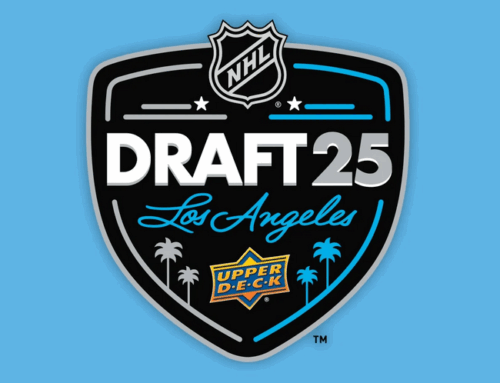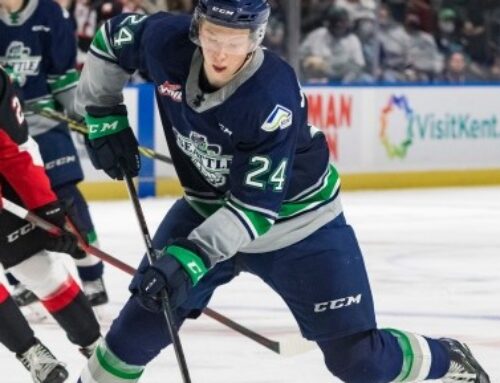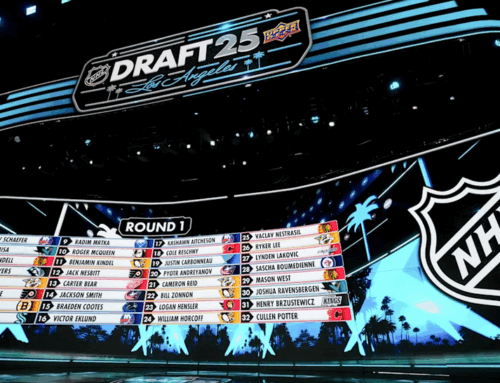Prospect Ramblings: Gleb Trikozov vs. Ivan Miroshnichenko — Toolkit vs. Tools
Hadi Kalakeche
2021-12-28
Welcome to my ramblings, where I’ll be writing down my thoughts on NHL and draft-eligible prospects once a week. I’ll be using the ramblings to keep you posted on the week’s events, or let you in on some questions I ask myself often regarding prospects, amateur scouting and player development.
First, I want to wish you all a happy holiday season, and hope that you’re safe and healthy amid rising cases worldwide. It’s been a busy week for men’s junior hockey (exclusively), and there are prospects doing their thing probably as you’re reading this, but I wanted to take a step back from WJC coverage and discuss two Russian draft-eligibles who aren’t playing in the tournament at the moment. These two prospects play on the same team, but you’ve likely only heard one of them mentioned in top-10 conversations: Ivan Miroshnichenko.
He’s been showing up in the top-10 of many a board, and was initially touted as a top-3 talent, but has started a downwards trend due to sub-par showings in the VHL for Omskie Krylia, scoring 11 points in 25 games so far using his tools — skating, stickhandling, shooting and size — without putting it all together in the form of a toolkit that’ll help him adapt on the fly (more on that later).
On the other hand, there’s Gleb Trikozov. One of the youngest prospects in this draft class as an August birthday, Trikozov managed to score 14 points in 15 MHL games and has had a slight glance at some VHL action, with two points in 11 games playing minimal ice-time. Although it seems that Miroshnichenko has the edge when looking at the stats sheet, the overall game that Gleb has shown to this point makes me think that he’s a better pick than Miro. I’ll outline the main differentiating factor between the two using my favorite hockey allegory, which fits perfectly here: Toolkit vs. Tools.
Miroshnichenko: The Tools
There aren’t many individual elements in Miroshnichenko’s game that need work; his shot is already well-refined, his skating is sound and powerful, he can battle for loose pucks, distribute them efficiently in simple situations, and can throw in deception to hit the lane he wants to. In terms of his tools, there isn’t much to criticize.
Ivan Miroshnichenko is going to be one of the league's best in the PP bumper position in a few years. He never stops moving, and his positioning makes it incredibly difficult for him to be covered by any specific defender, and when he times it well it looks like this: pic.twitter.com/dogZcfzMCK
— Josh Glazer (@jglazer9) August 24, 2021
One thing he won’t struggle to do, at any level, is score goals. His tremendous shot and his off-puck positioning are good enough to project him as a 20- or even 30-goal scorer at any level if he reaches his ceiling. Goal-scoring won’t be an issue.
The issue is his execution, and his intentions. What Miro struggles with the most is anticipating space and open teammates by thinking two or three passes ahead. He doesn’t seem to have the forward planning required to delay his options and play give-and-go hockey, which is the telltale sign of a lack of hockey sense. He makes rash decisions at times, rushing shots or passes instead of manipulating with patience and puck protection to find a better option. This is the Achilles’ heel of countless skilled prospects who play a high-octane offensive game, and what results is a player who is able to capitalize at his current level, but will almost always struggle to rack up points in the NHL outside of the power-play.
Another thing that has me low on Miro is his innate lack of high-end creativity. He gets tunnel-vision and fixates on outcomes rather than processes by always trying the first thing he sees, in a way that’s simple and straight-forward. He plays in a linear fashion, rarely using the boards or his teammates in complex ways.
In other words, his tools are very promising, but his toolkit isn’t refined enough to put it all together at high speeds and under pressure, and dictate the pace of play. Most, if not all of his goals come off of broken defensive coverage and wide-open nets for one-timers. He’ll score on the occasional rush chance by showing the desire to gain the middle, which is very projectable, but other than that, I don’t see many NHL-level thought processes in Miro’s game.
As a result, scouts who have kept a close eye on him over the last few months have began to slide him out of their top-10, including the EliteProspects scouting team who have him at 30th-overall. High enough that his skill level is reflected in his ranking, but low enough to indicate that better options exist, including Gleb Trikozov.
Trikozov: The Toolkit
One thing that’s almost always stood out to me about Trikozov is how much more complex his intake of the game is. He’ll often not only identify the right play, but also the best way to make it. A geometry pass, a quick give-and-go, an overlap or a skill move and he’s opened up space and made his teammates’ jobs way easier. He is very comfortable absorbing pressure, showing confidence in his edgework and puck protection to draw opponents in and clear up space.
The word “facilitator” couldn’t be a better fit for how Trikozov approaches the game.
The anticipation inherent to his game makes him such a good connector of plays. When Trikozov gets the puck, you can bet on the puck ending up in a better position than it was before he got it. He can work on the forehand and the backhand, and has a level of tenacity and drive that Miroshnichenko can only dream of. Although Gleb’s goal-scoring and skating might not be as refined as Miro’s, the bigger picture — how good he is at creating and facilitating possession and scoring chances for his team — is all in his favor.
Who to Pick, and Why?
Draft philosophies and scouting criteria are the main differentiating factor between teams and how they approach draft day, which ultimately results in teams being better at the stuff than others. In my opinion, the soundest draft philosophy a team can adopt is this order of priorities:
- Foundations/toolkit — skating posture, hockey sense, poise, tenacity, pressure management, execution speed, dictating the pace of play. The stuff you can’t teach easily that’ll set your prospect up for success from the get-go.
- Standout tools — the things a prospect can do that others can’t, which will define his game as he develops. Passing through seams, picking corners with shots regularly, outstanding puck control or speed, creating space for his teammates. Things that can be taught, but take a lot of time to refine.
- Raw tools — everything about a player that can and should be improved. Is his sub-par shot the only thing holding him back offensively? If his skating is below-average, does his posture allow for improvement in speed and acceleration as his legs grow stronger? Is his stick positioning an issue, or is he just bad at reading defensive plays?
Another thing few teams really try when it comes to drafting: right hand lists. Identify the prospects with little to nothing to give in priorities 1 and 2 who still manage to ride the hype all the way to draft day and remain in the mix, systematically excluding them from your scouting discussions. Start with prospects who have great foundations, and look outwards from there.
In that sense, I think Trikozov is the smarter pick, although Miroshnichenko is definitely worth a first-rounder; although the latter’s ceiling production-wise is higher, so much less work is needed to make the former an NHL-caliber forward, and the work that’s needed is peripheral. Very few of his improvements will need to come in foundational areas of his game, barring minor tweaks, which maximizes his chances of becoming an NHLer.
Thanks for reading — follow me on Twitter @HadiK_Scouting for all of your fantasy prospect needs!





